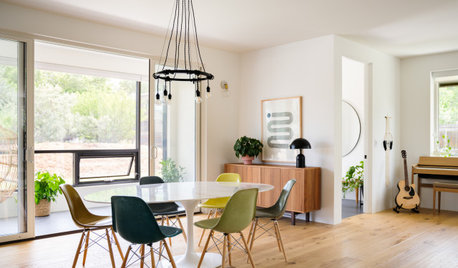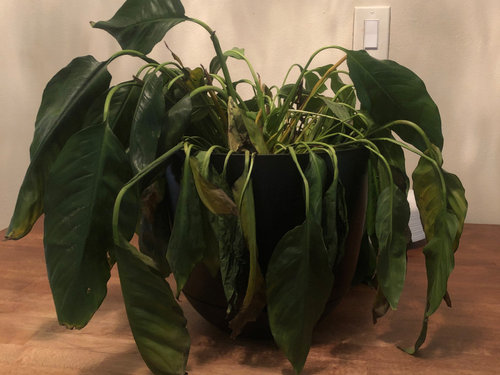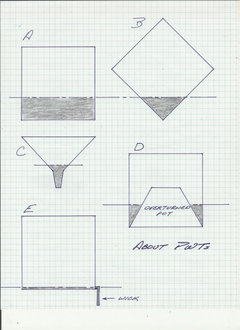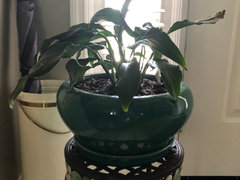Peace Lily won’t stop dying
Té Peezy
2 years ago
Featured Answer
Sort by:Oldest
Comments (32)
hc mcdole
2 years agoTé Peezy
2 years agoRelated Discussions
dying peace lily?
Comments (9)I agree with the sunburn diagnosis. PL's burn very easily. The light coming through mini blinds and sheers isn't enough, though. Somewhere that's not outside in the sunshine but is more brightly lit than the location it is pictured in would be good. Also agree with changing to soil to improve aeration but would personally do it with mulch instead of perlite. I don't like the looks of "white-top" soil and perlite just takes up space in the pot without offering any benefit to the plant. That soil is hard to see clearly but looks like it has a lot of peat which is hideous stuff that never seems to dry out until suddenly it's so dry it won't get wet again. Also "floats to the surface" like perlite. Read some of the other posts on here about PL's and other plants which contain root pruning advice from AL. You may decide more root pruning than you already did would be good. PL's make "pups" to increase themselves. Each individual part makes 1 leaf at a time and over time a PL can develop a whole family. Yours looks like 2 clumps where the biggest one has one growing eye and the other clump has 2 eyes. These clumps are probably still connected to each other by a root which could be severed so you could but each clump in a separtate pot, or back together in the same pot. It's been my experience that when PL's get severed from each other they usually send up new eyes and/or whole new pups....See Morepeace lily care
Comments (3)The brown ends of the leaves on a peace lily mean that you have too much minerals in the soil....either from over fertilizing or from repeatedly watering with hard water. Repotting should help with the hard water mineral build up issue, but then you added more minerals... since it seems to be over mineralized ..if that's a word..LOL!....water running through is good, washes the soil a bit. Also peace lily is a shade plant....suitable for very low light spots. Is it getting too much sun?...See Morepeace lily looking sickly... please help!
Comments (4)Try postings this in the Houseplants or Aroids forum. Peace lilies are not a "real" lily despite their common name and have nothing in common with true lilies :-))...See Morepeace lily plant looking sickly...please help!
Comments (17)I live just north of the "pits of hell," haha. Summers in Arkansas can be just as brutal, and humid. The temps here can climb up into the hundreds. That being said, I keep my Spathiphyllum outdoors in an area that gets dappled sun/partly shaded, and I keep it well watered. Right now it's blooming like crazy. Just the other day, I noticed that it has sent out a few more spathes. The hot and humid weather here is not much different than that of its native habitat. As long as they're kept well watered, they don't mind the shaded heat. It probably reminds them of home, so to speak. :)...See Moretapla (mid-Michigan, USDA z5b-6a)
2 years agoTé Peezy
2 years agoTé Peezy
2 years agotapla (mid-Michigan, USDA z5b-6a)
2 years agolast modified: 2 years agoCher S
2 years agoCher S
2 years agolast modified: 2 years agoTé Peezy
2 years agoWendyB 5A/MA
2 years agolast modified: 2 years agoCher S
2 years agoTé Peezy
2 years agoCher S
2 years agoCher S
2 years agoTé Peezy
2 years agoTé Peezy
2 years agoWendyB 5A/MA
2 years agoWendyB 5A/MA
2 years agoTé Peezy
2 years agotapla (mid-Michigan, USDA z5b-6a)
2 years agoTé Peezy
2 years agoHU-339052094
2 years agoWendyB 5A/MA
2 years agoTé Peezy
2 years agoHU-339052094
2 years agoTé Peezy
2 years agoTé Peezy
2 years agotapla (mid-Michigan, USDA z5b-6a)
2 years agoHU-954960519
last yeartapla (mid-Michigan, USDA z5b-6a)
last yearlast modified: last year
Related Stories

FEEL-GOOD HOME10 Tips for a More Peaceful Home
Turn your everyday living space into a serene retreat by clearing visual distractions, softening your lighting and more
Full Story
LANDSCAPE DESIGN9 Peaceful Garden Scenes to Bring a Moment of Serenity
Lose yourself in these beautiful gardens and see if any inspire design ideas for your outdoor space
Full Story
DECORATING GUIDESEntertaining: Hosts Pull Out the Stops for Kentucky Derby Parties
Walk through the lavishly appointed Malvern House as designer Lee W. Robinson shares tips for gatherings that go the distance
Full Story
LIFEHow to Handle Inherited Things You Don’t Really Want
Whether you’ve inherited a large collection of items or a single bulky piece of furniture, it’s OK to let it go if you don’t need or want it
Full Story
DECLUTTERINGCan’t Figure Out What ‘Sparks Joy’? Try This Question Instead
If you can’t decide whether to keep something or let it go, shift your perspective to find the answer
Full Story
MOST POPULAROrganizing? Don’t Forget the Essential First Step
Simplify the process of getting your home in order by taking it one step at a time. Here’s how to get on the right path
Full Story
DECLUTTERINGDecluttering — Don't Let Fear Hold You Back
Sure, you might make a mistake when tackling a decluttering project, but that's OK. Here's why
Full Story
FEEL-GOOD HOMEThe Anti-To-Do List: 10 Things You Don’t Need to Be Doing
Aren’t you busy enough? Give yourself a break and consider letting these tasks go
Full Story
FUN HOUZZ10 Things People Really Don’t Want in Their Homes
No love lost over fluorescent lights? No shocker there. But some of these other hated items may surprise you
Full Story
LIFEHard Winter? 9 Ways to Battle Cabin Fever
We know a lot of you are trapped where it just won’t stop snowing. Here are some ways to survive
Full Story












tapla (mid-Michigan, USDA z5b-6a)